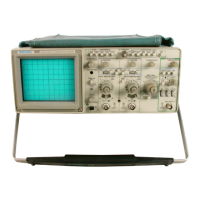Appendix B: Specification
*
Table A-5: Environmental Characteristics
Characteristics Performance Requirements
Environmental Requirements
The instrument meets the following MIL-T-28800D require
ments for Type III, Class 5, Style D equipment, except where
noted otherwise.1
Temperature
Operating
0° C to +50° C (+32° F to +122° F)1
Nonoperating
-40° C to +71° C (-40° F to +160° F)1
Tested to MIL-T-28800D, para 4.5.5.1.3 and 4.5.5.1.4, except
that in para 4.5.5.1.3 steps 4 and 5 (-10° C operating test)
are performed before step 2 (-40° C nonoperating test).
Equipment shall remain off upon return to room ambient tem
perature during step 6. Excessive condensation shall be re
moved before operating during step 7.
Altitude
Operating To 4,500 meters (13,716 feet)1
Maximum operating temperature decreases 1 ° C per 1,000
feet above 5,000 feet.
Nonoperating To 15,240 meters (50,000 feet)1
Exceeds requirements of MIL-T-2880D, para 4.5.5.2.
Humidity
Operating and Nonoperating 5 cycles (120 hours) referenced to M1L-T-28800D para
4.5.5.1.2.2 for Type III, Class 5 instruments. Operating and
nonoperating at 95%, -5% to +0%, relative humidity. Operat
ing, + 30s Cto +50° C; nonoperating, +30° Cto +60° C.1
EMI (eiectromagnetic interference)
Meets radiated and conducted emission requirements per
VDE 0871, Class B.1
To meet EMI regulations and specifications, use a double
shielded cable and metal connector housing with the housing
grounded to the cable shield on the AUXILIARY CONNEC
TOR.
Vibration
Operating
15 minutes along each of three major axes at a total displace
ment of 0.015 inch p-p (2.3 g at 55 Hz) with frequency varied
from 10 Hz to 55 Hz to 10 Hz in one-minute sweeps. Hold for
10 minutes at 55 Hz in each of the three major axes. All major
resonances are above 55 Hz.1
Meets requirements of MIL-T-228000, para 4.5.5.3.1.
Performance requirement not checked in manual.
A-22 Appendices

